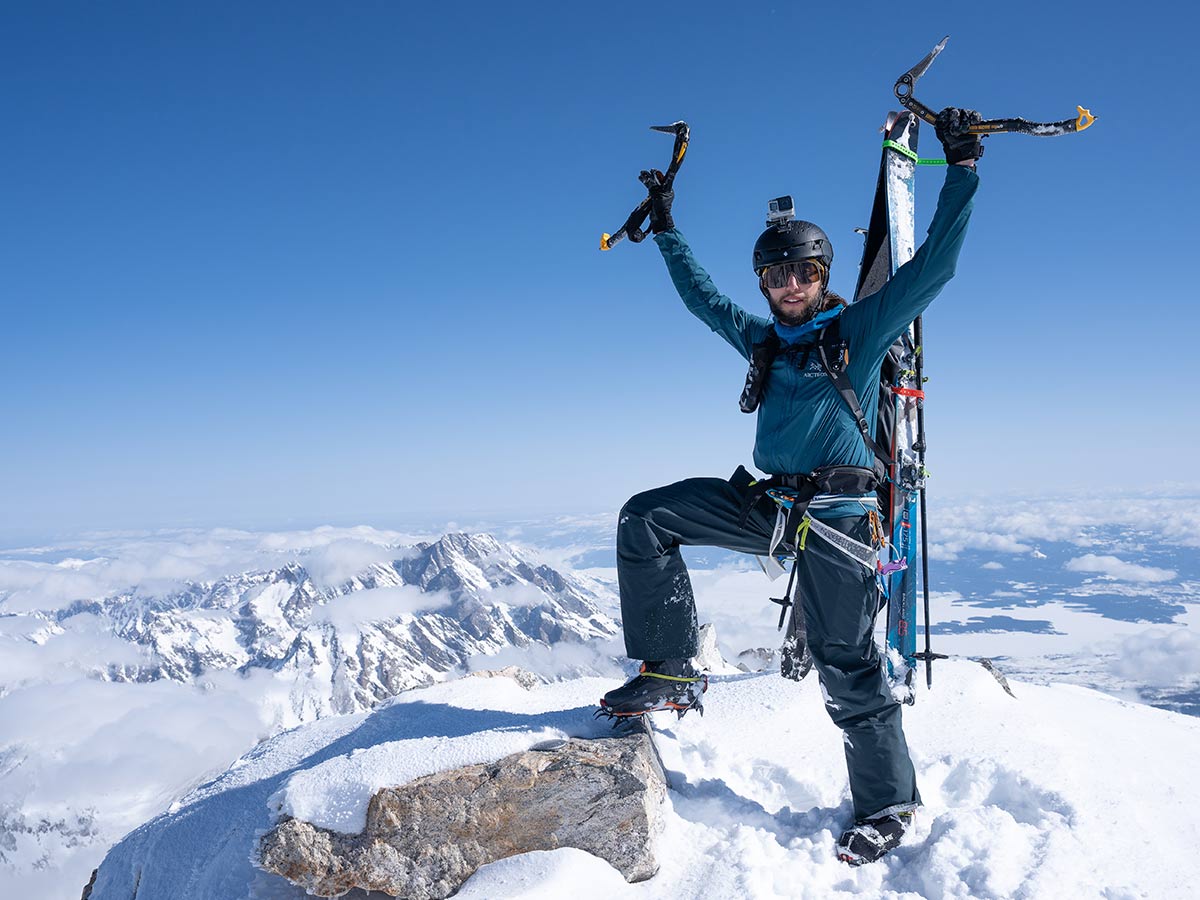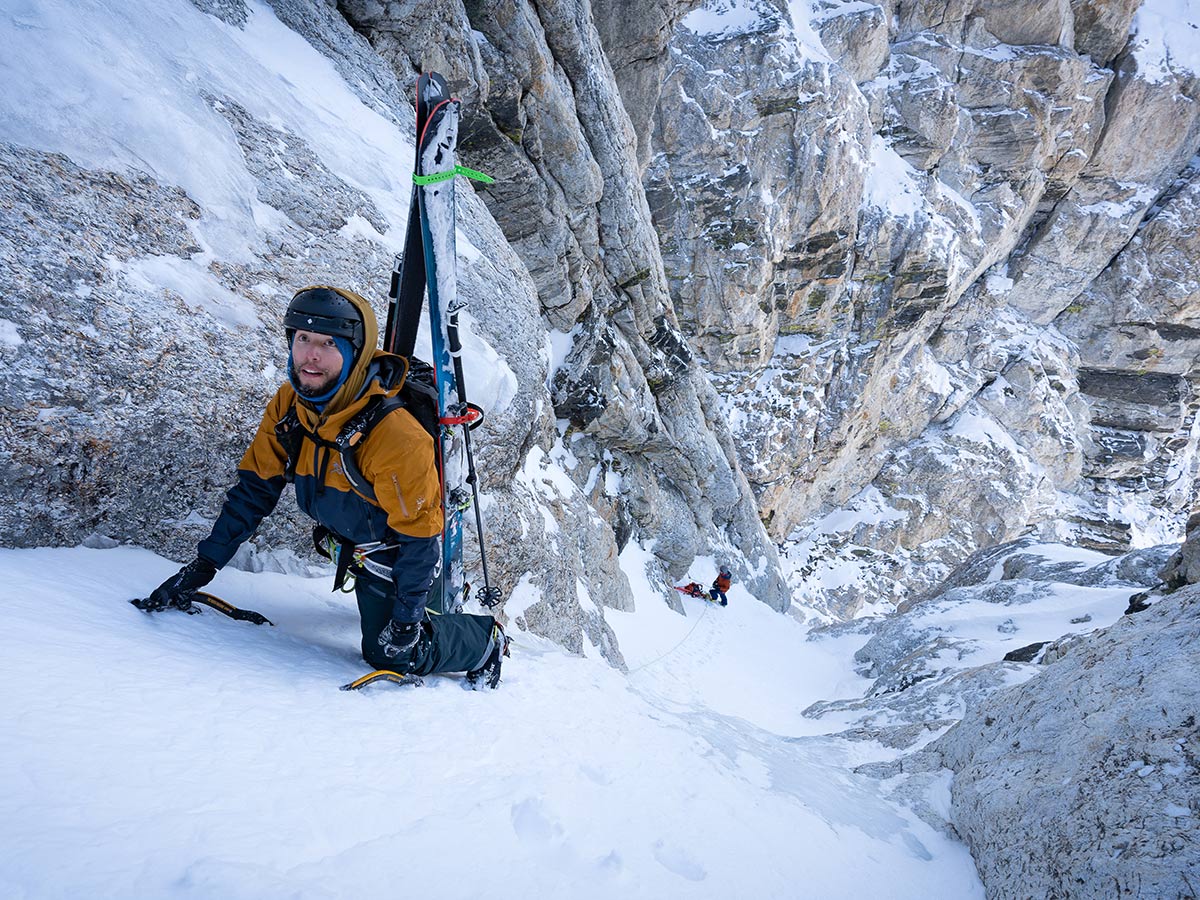Making History
onX ambassador Santiago Vega accomplishes the first disabled ski descent of the Grand Teton.
To be a part of Santiago “Santi” Vega’s family was to be a skier. It’s just what they did. His mom was a former alpine national champion in Chile, where he was born, and his maternal grandparents were both ski patrollers. So when Vega was born with a condition called fibular hemimelia, which led to an amputation of his lower leg before he was a year old, his parents did what any hardcore, passionate skiing parents would do.
“They strapped skis on my feet when I was two years old,” Vega said, laughing, during a recent Zoom interview from his home in Salt Lake City. Never mind that one of those feet was made from plastic, part of a prosthetic that extends all the way to his knee. “I grew up having a normal childhood, skiing with my parents and chasing my cousins.”
Flash forward a couple of decades, and it’s clear that 24-year-old Vega’s version of “normal” is extraordinary for any athlete: He completed the first-known disabled ski descent of the iconic Grand Teton, just outside Jackson, Wyoming.
It’s impossible to overstate how impressive of a feat this is. Skiing the 13,776-foot Grand is a huge accomplishment for even the most seasoned ski mountaineers who have two working legs. It involves a staggering vertical gain of 7,000 feet, ice climbing, exposed 50-degree skiing, and technical rappelling. It’s one of the 50 Classic Ski Descents in North America and one of the most photographed peaks in the world.
Before the question can be asked, Vega, who was still wearing ski clothes from a morning tour in Utah, credited his parents for giving him the confidence to attempt such a feat. “Growing up, I never got told that I couldn’t do something. Whenever I would ask them to get something for me, they would tell me to get it myself. They really struck the right balance of helping and encouraging me.”
Vega, who is now an onX ambassador, first got into backcountry skiing after the Sochi Olympics, where he competed on the Paralympic alpine team for Chile. (“I traded my twin-tips and tiny poles for a Peter Pan suit when I was 14,” he said.) After seeing a friend’s touring boots, he bought a pair of Alpine Trekkers (binding attachments that free your heel for the uphill) and some skins he found at a second-hand shop, and he headed out to a popular backcountry spot in Utah’s Wasatch Mountains with his 191 cm K2 Pontoons.
“I was miserable. It was a terrible experience,” he said. “And it was also so awesome. I knew I wanted to do it again.” He begged his parents for a setup for Christmas, and they bought him a pair of Dynastars with Frischi bindings. “I retrimmed the skins, and that was my gateway drug.”
Then, after the Olympics in Korea, where he tomahawked spectacularly on the slalom course and decided he was burned out on ski racing, he turned his full attention to ski touring. “I was getting more efficient, going farther, and skiing steeper things.” His leg, however, became a problem—he got blisters and hot spots, and had to figure out a custom prosthetic specific to backcountry skiing. He wished that he had more information available to him about what worked for other athletes, but because each disability is so individual, he was starting from scratch. “It was constant trial and error,” he said.
The Grand Teton had been on his mind since he was seven years old. He went on a road trip with his parents and grandparents, and he remembers his grandfather’s awe at seeing it. “He was so experienced in the mountains, and he didn’t see an easy way up it. Then I remember watching the storm clouds roll in—it was so sharp and dark and scary. I was really drawn to it.” He had been thinking seriously about skiing it since 2017, when he climbed it in the summer with some friends from college. “I knew what it took, and I knew I was pretty solid in my mountaineering but going down was a big question mark. And then this year I was feeling pretty strong, so I decided to go for it.”

Vega had been following a local Jackson Exum IFMGA guide and fellow onX ambassador named Mark Smiley on Instagram and reached out to him in January to see if he would help him. “He left me unread for, like, a day,” Vega said, laughing. When Smiley did reach back out to him, after doing a little social media stalking to make sure he was legit, he told Vega he wanted him to come to Jackson to do the Apocalypse Couloir first as a test piece. “I saw him ski that,” Smiley said, “and he did fine. So I said, ‘Let’s just do this thing.’”
Smiley, Vega, and another guide, Tim Cohn, had some honest conversations about the modifications they would need to make in order to be successful. Things like setting a boot pack with a shorter right step and stopping frequently so Vega could dry his leg to prevent blisters.
“We had to have some candid discussions about his disability. Whereas if I was at dinner with him or something, I wouldn’t even bring it up because that would be rude,” Smiley said. “I learned a lot. I think this accomplishment is an awesome start to a conversation, like, ‘Hey, not everyone is like you.’ I think this event can remove some of the ignorance and make people feel more comfortable to discuss disabilities.”
Then, right before he left for Jackson, Vega started having doubts. As he was packing, he broke down on the couch and cried with his wife. Then, on the Grand, with wind whipping the tents they were hunkered down in for a few hours before the summit, Vega felt himself spiral into fear again. Smiley and Cohn talked him through it and, other than one puckering moment on a traverse to the Glencoe Col, everything went smoothly. He summited without incident, wearing the ski patrol pin given to him by his grandfather, who passed away in 2015.

“The emotional learning and moral character that I’ve developed after skiing that…It’s been a life-changer,” he said. “I’m better now at acknowledging my own emotions and dealing with them. Real confidence is saying, ‘I’m scared and this is how I deal with my fear,’ and then making it into good fear instead of the paralyzing kind.”
As a modest guy, Vega has mixed feelings about the media attention his accomplishment is attracting. “I don’t ever want to make a big deal out of my leg,” he said. But ultimately, he comes back to his own yearning for more resources as he was just getting into the sport. “I wish I could have read a blog post about how you backcountry ski with a prosthetic. I want to let people know that we can do things like this. I hate the word ‘inspirational,’ but I do want to normalize this and inspire the adaptive community.”
As for his favorite moment of the journey, it had nothing to do with reporters and cameras and Instagram likes—or even, for that matter, reaching the summit. It was a very simple thing—a Kit Kat candy bar he buried in the snow at base camp. “When I came down and dug it up, that was when I knew everything was going to be OK. I had lived to ski another day. The months leading up to the Grand were so emotionally draining,” he said, looking down at his hands. “And right then, all the worries fell off my shoulders. I was so relieved.”
